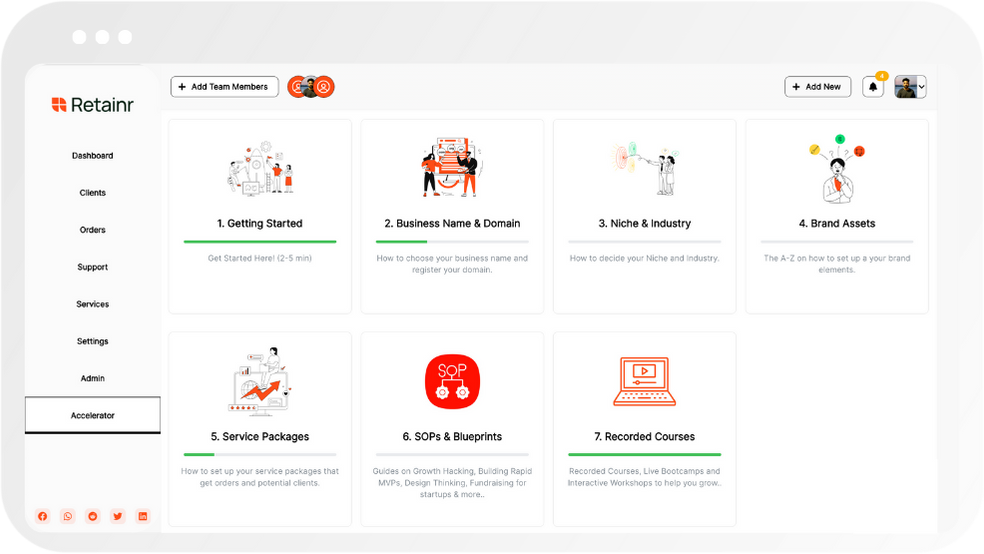
How to Create a Social Media Marketing Strategy in 11 Steps
Build with Retainr
Sell your products and services, manage clients, orders, payments, automate your client onboarding and management with your own branded web application.
Get Started1. What are the 11 steps to create a social media marketing strategy?
Step-by-Download: Social Media Marketing Strategy
Creating a comprehensive social media marketing strategy involves several crucial steps. These steps ensure you plan, execute and monitor your social media marketing effectively.
- Define your goals: Know why you're on social media. Is it for brand awareness, customer engagement or driving website traffic?
- Know your audience: Understand who your target audience is, their interests, their online habits and how they interact with your brand.
- Choose your platforms: Not every social media platform will be suitable for your business. Identify where your audience spends their time.
- Create valuable content: Your social media platforms should provide value to your audience and reflect your brand.
- Utilize a social media management tool: This will help organize, schedule, and analyze your posts.
Following Through with the Strategy
- Set up a social media calendar: This helps in planning and maintaining a consistent posting schedule.
- Engage with your audience: Respond to comments, mentions, and messages promptly.
- Monitor your performance: Track your key performance indicators (KPIs) to know if your strategy is working.
- Adjust strategy when necessary: Based on the insights from your KPIs, tweak your strategy for optimum performance.
- Capture leads: Convert your social media followers into potential customers for your service or product.
- Evaluate and refine your strategy: Constantly review your results and refine your strategy accordingly.
Table of Social Media Strategy
| Step | Task | Goal |
|---|---|---|
| 1 - 5 | Planning | Define objectives, understand audience, choose platforms, create content, use a management tool. |
| 6 - 11 | Implementation | Deploy calendar, interact with audience, monitor KPIs, adjust strategy, generate leads, refine strategy. |
2. How can I develop an effective social media marketing strategy?
Understand Your Business Goals
To develop an effective social media marketing strategy, firstly, you need to understand your business goals. These goals form the backbone of your strategy and give direction to your marketing efforts. Consider the following questions:
- What do you want to achieve through social media marketing?
- Are you trying to increase brand awareness or drive sales?
- Do you want to build a community or offer customer service?
Having clear answers to these questions will help point your strategy in the right direction.
Identify Your Target Audience
To ensure that your marketing strategies hit their mark, you need to understand who your target audience is. This is the group of people who are most likely to be interested in your product or service. You can identify your target audience by considering various demographic factors:
| Demographic Factor | Description |
|---|---|
| Age | What is the age range of your ideal customer? |
| Location | Where do your potential customers live? |
| Income Level | What is the income level of your ideal customer? |
| Interests & Hobbies | What are the interests and hobbies of your potential customers? |
Choose Your Social Media Platforms
The next step is to choose the social media platforms that you will use for your marketing strategy. Each platform caters to a unique demographic and is suited for different types of content.
- Facebook has the broadest age range and is good for business-to-consumer (B2C) companies.
- Instagram is popular with younger demographic and good for visual content.
- LinkedIn is best for business-to-business (B2B) companies and professional content.
- Twitter has a broad demographic and is suitable for sharing news and timely content.
Choose the platforms that align with your target audience and business goals.
3. What should be the first step when creating a social media marketing strategy?
The First Step in Creating a Social Media Marketing Strategy
To create a successful social media marketing strategy, the first step is to establish clear, measurable goals and objectives. These goals should be SMART (Specific, Measurable, Achievable, Relevant, and Time-bound). Having a clear end goal in sight will guide the entire strategy and give a benchmark against which to measure the success of your social media campaign.
List of Example SMART Goals
- Specific: Rather than just seeking to “increase engagement,” decide on a specific increase you want to achieve. For instance, aim for a 20% increase in shares over six months on a specific platform.
- Measurable: Choose objectives that you can track. For instance, “increase website traffic from social media by 30%” is a goal that can be measured using tools like Google Analytics.
- Achievable: Make sure your goals are realistic based on your company’s resources and audience size. It might not be feasible to aim for a million new followers in a month if your business is still small and growing.
- Relevant: Your social media goals should align with your overall business objectives. If your company’s main goal is to increase in-store sales, a social media goal might be to increase local awareness.
- Time-bound: Setting a timeframe for achieving your goal keeps you focused and helps measure success. For example, set a goal to increase newsletter sign-ups from social media by 15% within the next quarter.
Table of Social Media Marketing Goals
| Goal | SMART Objective |
|---|---|
| Increase Engagement | Increase "shares" by 20% in six months on Instagram |
| Increase Website Traffic | Increase website traffic from social media by 30% in the next quarter |
| Expand Audience | Gain 1000 new followers on Twitter within a month |
| Build Local Awareness | Increase social media mention from the local audience by 50% in two months |
| Sign up for Newsletters | Increase newsletter sign-ups from social media by 15% within the next quarter |
4. What are the key aspects to consider when developing a social media marketing strategy?
Understanding Your Audience
Before developing a social media strategy, one must fully grasp their audience demographic. This includes age, interests, geographic location, and preferred social platforms. Google Analytics and social media platforms provide detailed demographic information. This audience comprehension informs your content creation, platform selection, and targeted marketing.
- Age: Different age groups have varying social media preferences. Younger audiences lean more towards Instagram and Snapchat, while older audiences may prefer Facebook or LinkedIn.
- Interests: Discovering interests ensures content relevancy, which can increase engagement and shares.
- Geographic location: Helps with targeting ad campaigns and scheduling post times for maximum engagement.
- Preferred social platforms: Knowing where your audience spends most of their time ensures you focus efforts on pertinent sites.
Setting Achievable Goals
S.M.A.R.T objectives are the foundation of a strong social media strategy. They should be Specific, Measurable, Achievable, Relevant, and Time-bound. This strategy ensures goals are attainable and aligned with broader business objectives.
| S.M.A.R.T | Description |
|---|---|
| Specific | Goals should be straightforward and emphasize what you want to accomplish. |
| Measurable | Data should be quantifiable for trackability. |
| Achievable | Goals should be attainable, realistic, and not beyond reach. |
| Relevant | They should enhance your brand and align with your overall business strategy. |
| Time-bound | Setting a deadline keeps the momentum and lets you know when reassessment is needed. |
Engagement and Consistent Branding
A vital aspect of any social media strategy involves engagement. Interaction with your audience means more traffic and exposure, which, in turn, can lead to increased conversion rates. Consistent branding is also key. Your brand becomes recognizable with consistency across various platforms. Develop brand guidelines for voice, tone, and aesthetic.
- Engagement: Prompt engagement by posing questions, responding to comments, reposting user-generated content, and initiating competitions. Monitor metrics to know what content manages highest engagements.
- Consistent Branding: Consistency establishes trust and recognition. Use the same profile pictures, color scheme, posting style and stick to your brand’s voice in all posts and responses.
5. Why is it important to define target audience in social media marketing strategy?
Importance of Defining Target Audience
There are several reasons why defining a target audience is crucial in a social media marketing strategy. Understanding the target audience can significantly impact the success of your marketing efforts.
- Increased Efficiency: Knowing your target audience narrows your focus which makes your marketing strategies more efficient. By focusing on a specific group, you waste less time and resources on those who are unlikely to be interested in your products or services.
- Greater Engagement: Understanding your audience's interests, preferences, and needs helps in creating content that resonates with them, leading to increased engagement and interaction with your brand.
- Better Conversion Rates: When you understand who your target audience is and their needs, you can more effectively persuade them to purchase your product or service. This results in higher conversion rates and increased revenue.
Impact of Target Audience on Marketing Strategy
The effective use of a defined target audience profoundly impacts the development and execution of your social media marketing strategy. The following table highlights key aspects of marketing strategy and how they are influenced by a well-defined target audience.
<| Marketing Strategy Aspect | Impact of Target Audience |
|---|---|
| Content Creation | Knowing who your target audience is can guide the creation of relevant and engaging content. |
| Platform Choice | Understanding your audience's preferred social media platforms determines where you invest your marketing resources. |
| Advertising | Detailed audience demographics help in tailoring precise ad strategies that hit the right consumers. |
| Product Development | Customer feedback from the target group can inform product development and enhancements. |
Conclusion
In conclusion, to have an effective social media marketing strategy, you first need to define your target audience. This step is vital as it lays the foundation for the direction of your marketing efforts. It reduces resource wastage, increases engagement and conversions, and ultimately, drives business growth.
6. What role does content play in social media marketing strategy?
The Importance of Content in Social Media Marketing Strategy
Content is of paramount importance in social media marketing strategies. It is the bridge that connects your business and your target audience. It's your business' voice in the social media world and the way you can engage your audience, create relationships, and ultimately drive sales. Hence, content can be deemed as the soul of your social media marketing strategy.
Quality and Relevance in Content Creation
When planning your content, two main features are to be considered; quality and relevance. The quality of your content can determine how your audience perceives your brand. High-quality content can build a positive impression, increase audience engagement, and drive conversions. Meanwhile, relevance is critical to connect with your target audience. Your content should be tailored to your audience's interests, needs, and wants. It's also important to keep up with social media trends to make your content timely and relevant.
- Quality: Images should be clear and texts should be free from grammatical errors.
- Relevance: Put your audience in mind when creating content, it should align with their interests.
Content Types in Social Media Marketing Strategy
There are different types and formats of content that you can incorporate into your social media marketing strategy, all of which serve different purposes and engage your audience in different ways. These include informational posts, promotional posts, user-generated content, and interactive content.
| Content Type | Description |
|---|---|
| Informational Posts | These provide valuable information to your audience about your industry or business |
| Promotional Posts | These advertise your products or services, and stimulate interest in your offerings |
| User-Generated Content | These are created by your audience, showing your products or services in action |
| Interactive Content | These require active engagement from your audience, such as polls or quizzes |
7. How can I measure the success of my social media marketing strategy?
Track Key Performance Indicators (KPIs)
Measuring the success of a social media marketing strategy is easier when you know which Key Performance Indicators (KPIs) to monitor. These indicators are specific and measurable goals that reflect the effectiveness of your strategy. Some essential KPIs include:
- Engagement rate: the total engagement (likes, comments, and shares) divided by the total followers
- Reach: the number of unique users who saw your post
- Website traffic: the number of visitors redirected to your site from social media
Utilize Social Media Analytics Tools
Various tools can help you accurately measure these KPIs. Most social media platforms have integrated analytics features that provide insights into your account's performance. Apart from these, third-party tools can provide comprehensive social media analytics and compare performance across multiple platforms.
| Tool | Functionality |
|---|---|
| Facebook Insights | Facebook's native analytics tool provides detailed metrics about your posts and audience engagement. |
| Google Analytics | You can track your website traffic from social media and examine user behavior on your site. |
| Hootsuite | This tool allows you to manage and track performance across multiple social media accounts from a single dashboard. |
Conduct A/B Testing
A/B testing is another way to measure the success of your social media marketing strategy. It allows you to test different versions of your posts to see which performs better. Through A/B testing, you can refine your content strategy and better understand what type of content resonates with your audience. Things to consider in A/B testing include:
- Post format: photo vs. video vs. text
- Posting time: morning vs. afternoon vs. night
- Call to action: different phrasing or placement
8. How often should I review and update my social media marketing strategy?
Reviewing and Updating Your Social Media Strategy
Your social media marketing strategy should not be stagnant. It needs to be periodically reviewed and updated to ensure that it is still effectively serving your business and aligning with your goals. As a general rule of thumb, it is advisable to review your strategy every quarter, although depending on your circumstances, you might need to review it more frequently.
- Quarterly Review: This is usually sufficient for most businesses. It allows you to determine what's working, what isn't, and make changes accordingly.
- Monthly Review: If your social media campaign is more aggressive or your business environment is quickly changing, monthly reviews might be more suitable.
- Weekly/Bi-Weekly Review: If you're just starting out or if there are significant fluctuations in your industry, you might need to check in on your strategy more frequently.
Aspects to Review in Your Social Media Strategy
When reviewing your social media strategy, there are a few key aspects that you should focus on. These include your goals and objectives, the performance of your content, audience engagement and growth numbers, and overall return on investment (ROI). The table below identifies these areas to review and the key questions related to each.
| Aspect | Key Questions |
|---|---|
| Goals and Objectives | Are your current goals and objectives still relevant and aligned with your overall business strategy? |
| Content Performance | Which content is performing well? Which isn't? What could potentially be the reason for this performance? |
| Audience Engagement | Are you experiencing growth in your audience numbers? Are your engagement rates consistent/increasing? |
| Return on Investment(ROI) | Are your SMM efforts yielding an acceptable ROI? Is there an area where re-allocation of resources could improve ROI? |
Remember, consistency and adaptability are key when it comes to social media marketing. Regular reviews and updates will entrust that your strategy stays effective and relevant.
9. How can I use insights and analytics in shaping my social media marketing strategy?
Utilizing Insights and Analytics
Insights and analytics are pivotal in shaping a robust and effective social media marketing strategy. They provide valuable data on user behavior, demographics, engagement metrics, and content success, which you can use to refine your approach and maximize results. Here are three steps to utilize insights and analytics:
- Identify Key Metrics: Several metrics such as reach, clicks, engagement, likes, shares, comments, follower growth, and conversions can help you assess the effectiveness of your strategy. It's essential to identify the key metrics that align with your goals to ensure you're measuring the right things.
- Analyze Data: Once you have identified your key metrics, dive into the data. Look for patterns, trends, and any significant anomalies. Tools such as Google Analytics, Facebook Insights, or Twitter Analytics can offer you a wealth of information.
- Apply Findings: After analysis, apply these findings to tweak your social media strategy. This can mean modifying your content type, posting schedule, or engagement techniques based on what resonates most with your audience.
Benefits of Using Insights and Analytics
Insights and analytics offer various benefits in shaping your social media marketing strategy. They enable you to:
- Understand your audience better - discover their location, interests, online activity periods, and demographic characteristics.
- Track the performance of your posts and ads - determine what content is driving engagement and conversions.
- Optimize your strategy - make data-driven decisions rather than relying purely on assumptions or predictions.
Key Social Media Metrics
Here's a breakdown of critical social media metrics that can inform your strategy:
| Metrics | Description |
|---|---|
| Reach | Number of unique users who have seen your post |
| Engagement | Total interactions divided by the number of impressions |
| Clicks | Number of times users have clicked on your post or link |
| Conversions | Number of desired actions completed, such as making a purchase or signing up to a newsletter |
10. What are the best practices for creating a social media marketing strategy that drives engagement and conversions?
Best Practices for Creating a Social Media Marketing Strategy
Creating an effective social media marketing strategy requires precise moves. The following best practices could enhance your strategic planning, driving more engagement and resulting in higher conversion rates:
- Know your audience: This means designing content that appeals to your target demographics. Do not forget to consider the platforms they use most frequently.
- Create engaging content: This is the key to grabbing your audience’s attention. Whether it’s eye-catching graphics or compelling copy, make sure your content is shareable, relevant and engaging.
- Consistent posting: Consistency is key in social media marketing. A consistent voice, post cadence, and style help convey your brand personality.
Advanced Practices for Optimum Results
Once you've mastered the basics, you can push your strategy farther by integrating advanced strategies. These steps can help you fine-tune your approach for maximum engagement and conversions:
- Invest in social media advertising: Paid social ads help to increase your reach and visibility, driving more traffic to your landing pages.
- Utilize social listening: This is about observing trends and discussions about your brand or industry on social media. It allows you to extract key insights and respond appropriately.
- Track and analyze performance: This process enables you to understand what works and what does not, leading to more strategic and successful campaigns in the future.
Ongoing Monitoring and Adjustments
Building an effective social media marketing strategy is not a one-time task. Ongoing monitoring and adjustments are necessary to keep the strategy relevant and efficient. Below is an illustrative table summarizing the four important steps in every successful strategy:
| Steps | Description |
|---|---|
| 1. Set clear goals | Target outcomes should be clear, specific, and measurable. |
| 2. Identify target audience | Determine demographics, behaviors, preferences, and the social platforms they frequent. |
| 3. Create and curate content | Develop engaging content in line with brand voice and audience preferences. |
| 4. Monitor and adjust | Track performance and adjust the strategy as necessary to optimize results. |
Conclusion
Create a Comprehensive Social Media Marketing Strategy with These 11 Steps
Creating successful online presence heavily relies on a solid social media marketing strategy. We will guide you through 11 steps to develop this strategy.
Define your goals
Start by outlining your business’ primary objectives. Clearly defined goals provide a direction for your social media efforts and a benchmark to measure your success.
Identify your audience
Knowing your target audience is essential. Being familiar with their preferences and behaviors can help you create relevant and engaging content.
Choose your social platforms
Choose social media platforms popular among your target audience to maximise engagement.
Create a content strategy
With your goals, audience, and platform established, the next step is to design a content strategy. This includes selecting topics, setting a schedule, and deciding on the content format.
Implement a social media management tool
Using a social media management tool like Retainr.io can streamline scheduling and monitoring, making your social media marketing more efficient.
Keep learning and adapting
Digital marketing trends are constantly evolving. Stay updated and be flexible to adapt your strategy accordingly.
Using Retainr.io for Social Media Marketing
Retainr.io, a white-label software, helps agencies and businesses manage their social media marketing strategies. Not only does it empower you to manage clients, orders, and payments in your own branded app, but it also facilitates effective customer communication – making it an all-in-one solution for maintaining a strong online presence.
To strategically and efficiently manage your social media marketing, try Retainr.io today!
Boost Your Agency Growth
with Retainr Accelerator
Uncover secrets, strategies, and exclusive blueprints to take your agency's growth to the next level — from marketing insights to effective presentations and leveraging technology.

SOPs, Cheatsheets & Blueprints
Leverage 50+ SOPs (valued over $10K) offering practical guides, scripts, tools, hacks, templates, and cheat sheets to fast-track your startup's growth.
Connect with fellow entrepreneurs, share experiences, and get expert insights within our exclusive Facebook community.
.jpg)

Join a thriving community of growth hackers. Network, collaborate, and learn from like-minded entrepreneurs on a lifelong journey to success.

Gain expertise with recorded Courses, Live Bootcamps and interactive Workshops on topics like growth hacking, copywriting, no-code funnel building, performance marketing and more, taught by seasoned coaches & industry experts.

.jpg)

.jpeg)


